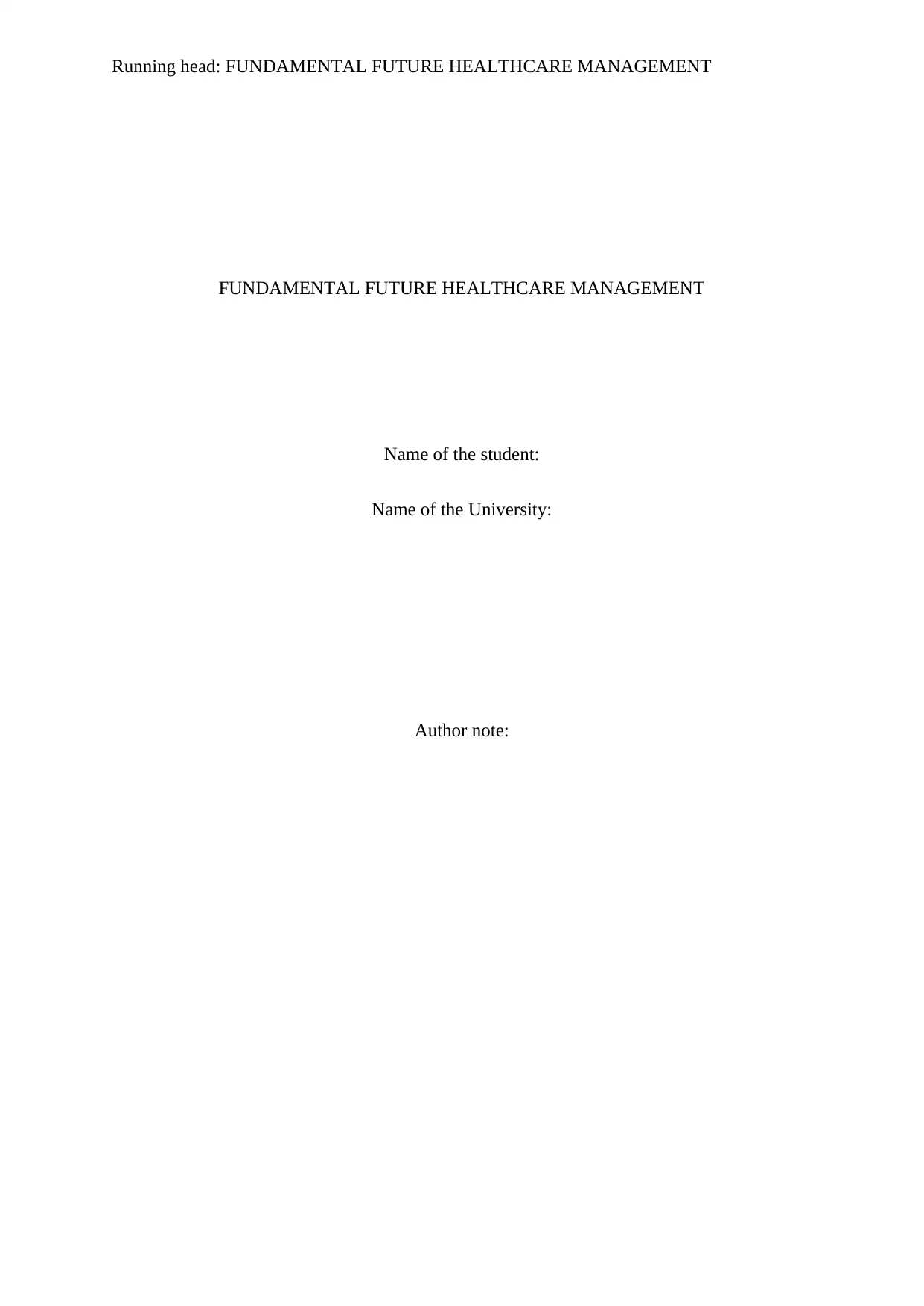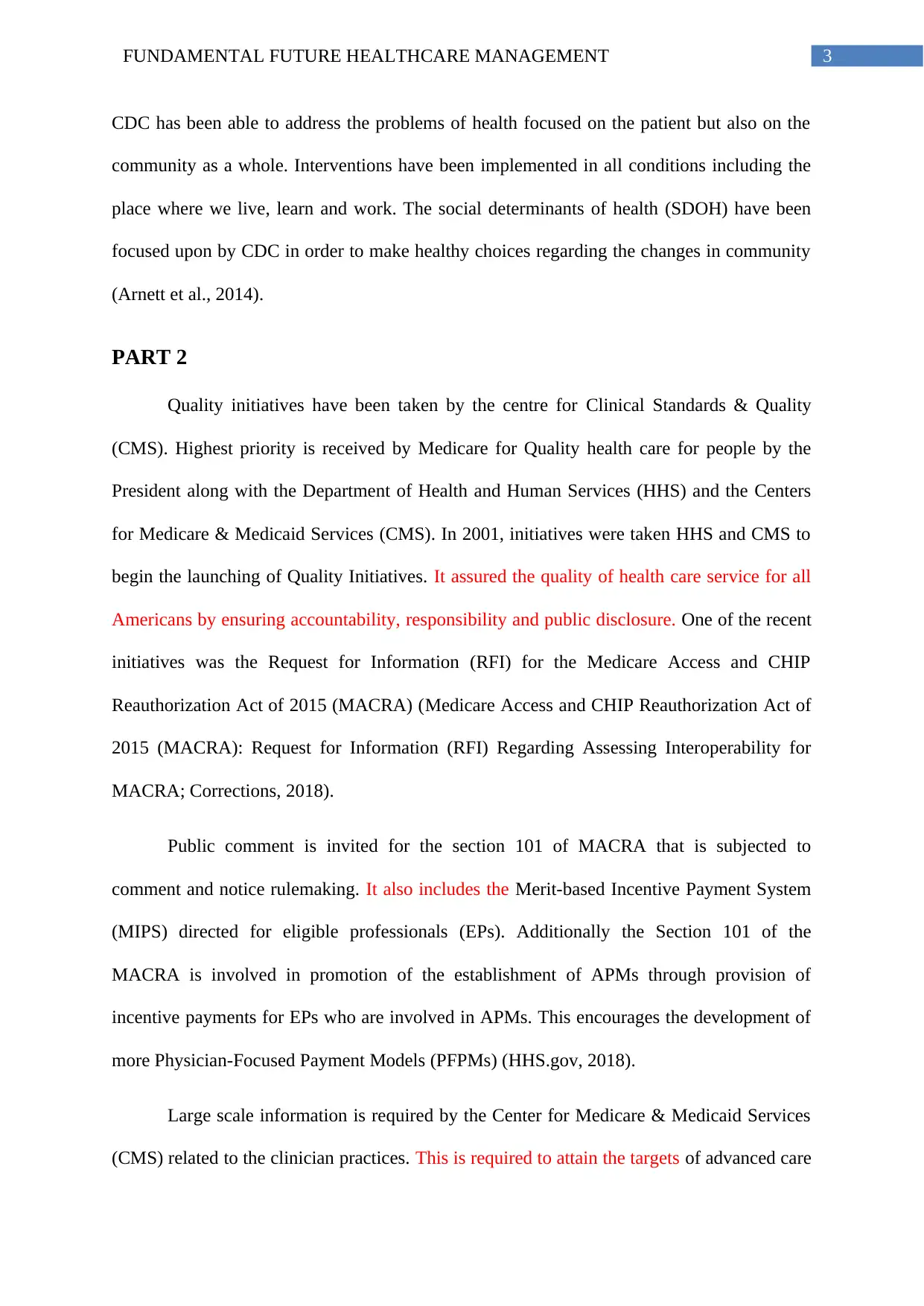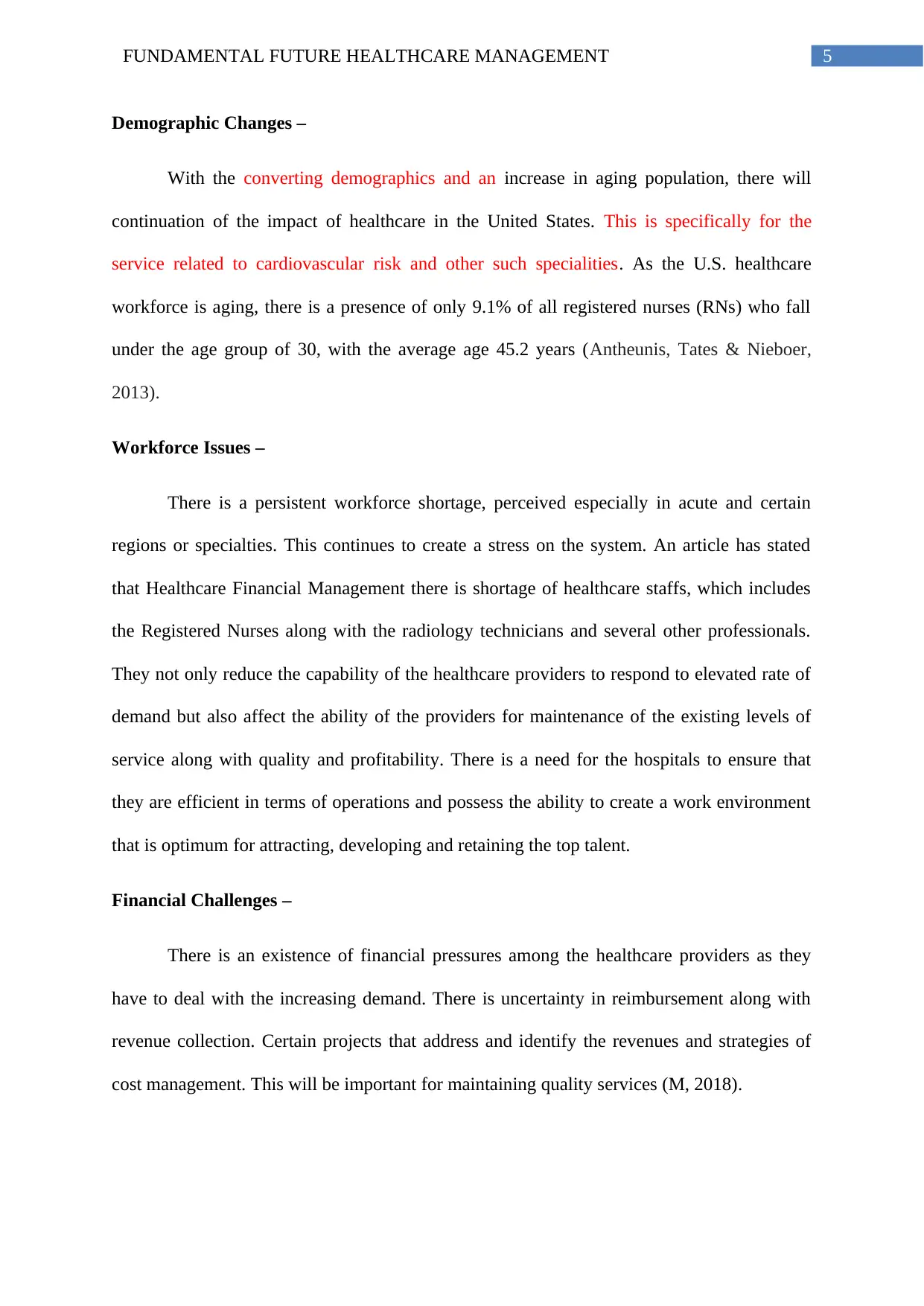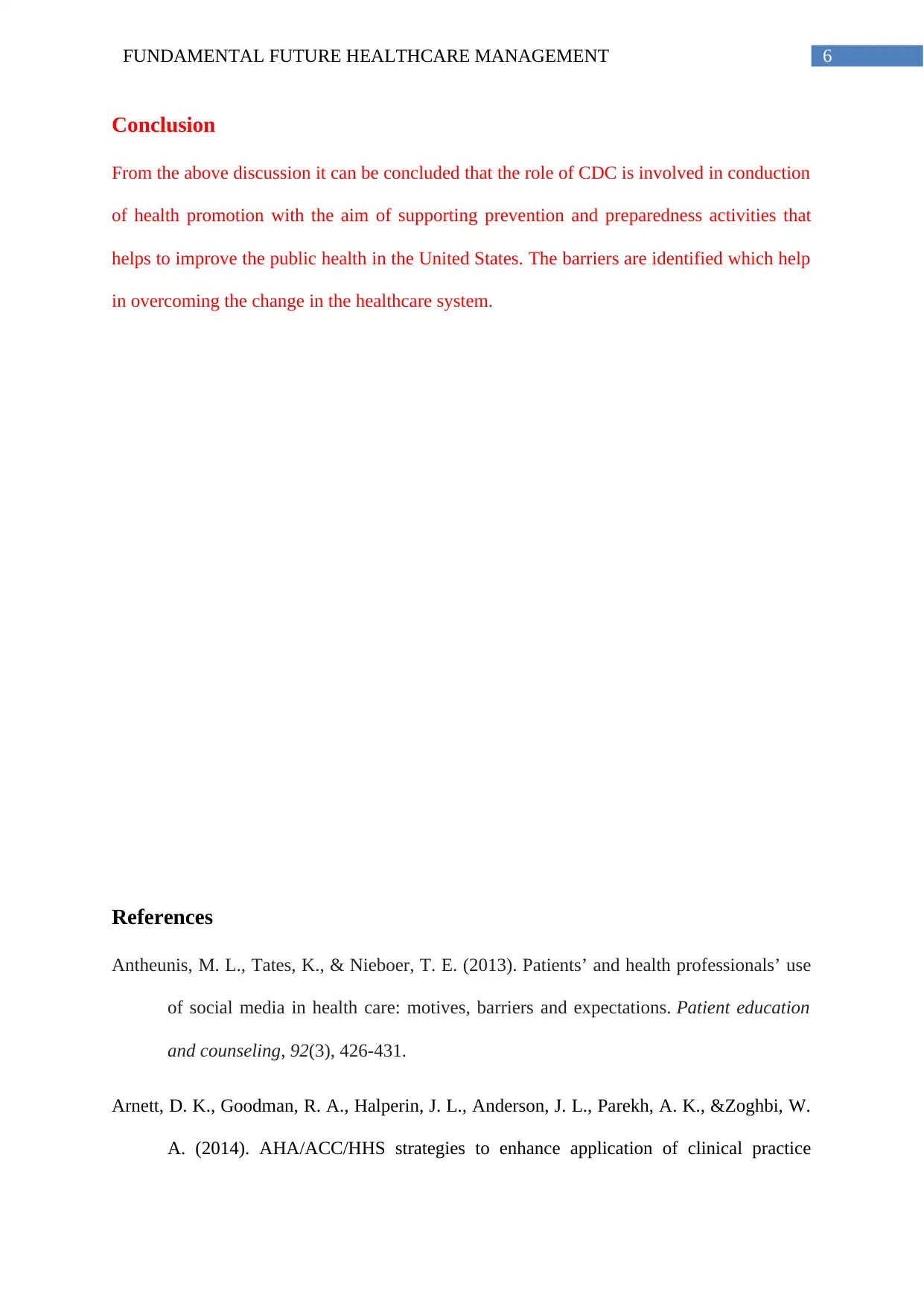Analyzing CDC's Role, Health Policies, and Implementation Barriers
VerifiedAdded on 2023/06/10
|9
|2119
|407
Report
AI Summary
This report provides an overview of the Centers for Disease Control and Prevention (CDC) and its role in promoting public health in the United States. It discusses the CDC's strategic areas of focus, including supporting local and state health departments, improving global health, and decreasing leading causes of death. The report also examines health reforms, such as the Patient Protection and Affordable Care Act (PPACA), and the policies and regulations governed by the Department of Health and Human Services (HHS). Furthermore, it delves into quality initiatives taken by the Center for Clinical Standards & Quality (CMS), including the Medicare Access and CHIP Reauthorization Act of 2015 (MACRA). Finally, the report identifies barriers to change in the healthcare system, such as patient safety concerns, the move toward digitization, demographic changes, workforce issues, and financial challenges, emphasizing the need for efficient operations and a supportive work environment.

Running head: FUNDAMENTAL FUTURE HEALTHCARE MANAGEMENT
FUNDAMENTAL FUTURE HEALTHCARE MANAGEMENT
Name of the student:
Name of the University:
Author note:
FUNDAMENTAL FUTURE HEALTHCARE MANAGEMENT
Name of the student:
Name of the University:
Author note:
Paraphrase This Document
Need a fresh take? Get an instant paraphrase of this document with our AI Paraphraser

1FUNDAMENTAL FUTURE HEALTHCARE MANAGEMENT
Introduction
U.S. Federal Health Care Agencies play the role of controlling health hazards especially for
diseases which have newly emerged. Standards are created by the agencies for protection of
the public health system. This paper highlights the role of a specific U.S. Federal Health Care
Agency. Here the role of Centers for Disease Control and Prevention (CDC) has been
discussed. Additionally the paper discusses how the National Academies of Sciences,
Engineering and Medicine (IOM) core metrics for health and health care progress and public
health management approaches are related to the initiative. Along with this the barriers for
the change implementation are also identified.
PART 1
Centers for Disease Control and Prevention (CDC) is a federal agency that is
involved in conduction of health promotion with the aim of supporting prevention and
preparedness activities that helps to improve the public health in the United States (CDC
Works 24/7, 2018). The agency was developed in Atlanta, in the year 1946. This is managed
by the Department of Health and Human Services (HHS) (HHS.gov, 2018). The CDC is
involved in partnership with the other national and state level organizations to monitor as
well as prevent situations related to outbreaks which includes bioterrorism. It also aims to
prevent infectious and chronic diseases including the workplace hazards, injuries and threats
of environmental health. CDC projects its focus majorly on five strategic areas which
includes elevation the amount of support that is provided to the local and state health
departments along with improvement of global health. Its objects also includes decrease of
the leading causes of death. Additionally the focus is on strengthening surveillance along
with reforming of health policies. Apart from these, the CDC plays multiple roles which
includes coordination and technical support though which it tends to meet the health security
Introduction
U.S. Federal Health Care Agencies play the role of controlling health hazards especially for
diseases which have newly emerged. Standards are created by the agencies for protection of
the public health system. This paper highlights the role of a specific U.S. Federal Health Care
Agency. Here the role of Centers for Disease Control and Prevention (CDC) has been
discussed. Additionally the paper discusses how the National Academies of Sciences,
Engineering and Medicine (IOM) core metrics for health and health care progress and public
health management approaches are related to the initiative. Along with this the barriers for
the change implementation are also identified.
PART 1
Centers for Disease Control and Prevention (CDC) is a federal agency that is
involved in conduction of health promotion with the aim of supporting prevention and
preparedness activities that helps to improve the public health in the United States (CDC
Works 24/7, 2018). The agency was developed in Atlanta, in the year 1946. This is managed
by the Department of Health and Human Services (HHS) (HHS.gov, 2018). The CDC is
involved in partnership with the other national and state level organizations to monitor as
well as prevent situations related to outbreaks which includes bioterrorism. It also aims to
prevent infectious and chronic diseases including the workplace hazards, injuries and threats
of environmental health. CDC projects its focus majorly on five strategic areas which
includes elevation the amount of support that is provided to the local and state health
departments along with improvement of global health. Its objects also includes decrease of
the leading causes of death. Additionally the focus is on strengthening surveillance along
with reforming of health policies. Apart from these, the CDC plays multiple roles which
includes coordination and technical support though which it tends to meet the health security

2FUNDAMENTAL FUTURE HEALTHCARE MANAGEMENT
goals. The goals comprises of prevention, detection and responding to the investments in
global health (Johnson et al., 2014).
In the context of CDC, the health reforms were conducted in 2013, when president
Obama signed the Patient Protection and Affordable Care Act. This law was known as
PPACA (Arnett et al., 2014). This health reform legislation includes the development of the
new programs of prevention and aims to monitor the public health workforce. These include
the Patient Protection and Affordable Care Act, the HHS prevention and public health fund,
the national public health improvement initiative (NPHII) and lastly the national prevention
strategy (M, 2018).
The policies and regulations of CDC are governed by the Department of Health and
Human Services (HHS). The HHS issue regulations are involved in implementation of laws
that develops policies and provides guidance for the industries and the local and state
governments. The page of the HHS Regulations covers the information on the strategies of
health information technology along with the Health Insurance Portability and Accountability
Act (HIPAA) (Croft & Parish, 2013). Additionally there is a mention of other laws and
regulations. A recent vital hepatitis action plan has been proposed by CDC which will help to
battle the viral hepatitis in United States between the year 2017 and 2020. The strategies
included in the plan are given as four goals. The first goal is prevention of viral hepatitis
infections that are new. The second goal state reduction of deaths and improvement of health
of individuals suffering from viral hepatitis. The third goals mentions that there should be
reduction of hepatitis health disparities and the final goal reflects that there should
coordination and monitoring of the implementation of activities of viral hepatitis (Grol et al.,
2013)
goals. The goals comprises of prevention, detection and responding to the investments in
global health (Johnson et al., 2014).
In the context of CDC, the health reforms were conducted in 2013, when president
Obama signed the Patient Protection and Affordable Care Act. This law was known as
PPACA (Arnett et al., 2014). This health reform legislation includes the development of the
new programs of prevention and aims to monitor the public health workforce. These include
the Patient Protection and Affordable Care Act, the HHS prevention and public health fund,
the national public health improvement initiative (NPHII) and lastly the national prevention
strategy (M, 2018).
The policies and regulations of CDC are governed by the Department of Health and
Human Services (HHS). The HHS issue regulations are involved in implementation of laws
that develops policies and provides guidance for the industries and the local and state
governments. The page of the HHS Regulations covers the information on the strategies of
health information technology along with the Health Insurance Portability and Accountability
Act (HIPAA) (Croft & Parish, 2013). Additionally there is a mention of other laws and
regulations. A recent vital hepatitis action plan has been proposed by CDC which will help to
battle the viral hepatitis in United States between the year 2017 and 2020. The strategies
included in the plan are given as four goals. The first goal is prevention of viral hepatitis
infections that are new. The second goal state reduction of deaths and improvement of health
of individuals suffering from viral hepatitis. The third goals mentions that there should be
reduction of hepatitis health disparities and the final goal reflects that there should
coordination and monitoring of the implementation of activities of viral hepatitis (Grol et al.,
2013)
⊘ This is a preview!⊘
Do you want full access?
Subscribe today to unlock all pages.

Trusted by 1+ million students worldwide

3FUNDAMENTAL FUTURE HEALTHCARE MANAGEMENT
CDC has been able to address the problems of health focused on the patient but also on the
community as a whole. Interventions have been implemented in all conditions including the
place where we live, learn and work. The social determinants of health (SDOH) have been
focused upon by CDC in order to make healthy choices regarding the changes in community
(Arnett et al., 2014).
PART 2
Quality initiatives have been taken by the centre for Clinical Standards & Quality
(CMS). Highest priority is received by Medicare for Quality health care for people by the
President along with the Department of Health and Human Services (HHS) and the Centers
for Medicare & Medicaid Services (CMS). In 2001, initiatives were taken HHS and CMS to
begin the launching of Quality Initiatives. It assured the quality of health care service for all
Americans by ensuring accountability, responsibility and public disclosure. One of the recent
initiatives was the Request for Information (RFI) for the Medicare Access and CHIP
Reauthorization Act of 2015 (MACRA) (Medicare Access and CHIP Reauthorization Act of
2015 (MACRA): Request for Information (RFI) Regarding Assessing Interoperability for
MACRA; Corrections, 2018).
Public comment is invited for the section 101 of MACRA that is subjected to
comment and notice rulemaking. It also includes the Merit-based Incentive Payment System
(MIPS) directed for eligible professionals (EPs). Additionally the Section 101 of the
MACRA is involved in promotion of the establishment of APMs through provision of
incentive payments for EPs who are involved in APMs. This encourages the development of
more Physician-Focused Payment Models (PFPMs) (HHS.gov, 2018).
Large scale information is required by the Center for Medicare & Medicaid Services
(CMS) related to the clinician practices. This is required to attain the targets of advanced care
CDC has been able to address the problems of health focused on the patient but also on the
community as a whole. Interventions have been implemented in all conditions including the
place where we live, learn and work. The social determinants of health (SDOH) have been
focused upon by CDC in order to make healthy choices regarding the changes in community
(Arnett et al., 2014).
PART 2
Quality initiatives have been taken by the centre for Clinical Standards & Quality
(CMS). Highest priority is received by Medicare for Quality health care for people by the
President along with the Department of Health and Human Services (HHS) and the Centers
for Medicare & Medicaid Services (CMS). In 2001, initiatives were taken HHS and CMS to
begin the launching of Quality Initiatives. It assured the quality of health care service for all
Americans by ensuring accountability, responsibility and public disclosure. One of the recent
initiatives was the Request for Information (RFI) for the Medicare Access and CHIP
Reauthorization Act of 2015 (MACRA) (Medicare Access and CHIP Reauthorization Act of
2015 (MACRA): Request for Information (RFI) Regarding Assessing Interoperability for
MACRA; Corrections, 2018).
Public comment is invited for the section 101 of MACRA that is subjected to
comment and notice rulemaking. It also includes the Merit-based Incentive Payment System
(MIPS) directed for eligible professionals (EPs). Additionally the Section 101 of the
MACRA is involved in promotion of the establishment of APMs through provision of
incentive payments for EPs who are involved in APMs. This encourages the development of
more Physician-Focused Payment Models (PFPMs) (HHS.gov, 2018).
Large scale information is required by the Center for Medicare & Medicaid Services
(CMS) related to the clinician practices. This is required to attain the targets of advanced care
Paraphrase This Document
Need a fresh take? Get an instant paraphrase of this document with our AI Paraphraser

4FUNDAMENTAL FUTURE HEALTHCARE MANAGEMENT
and lower cost of better health. Practice Transformation reflects the process that results in
changes of observable and measurable nature in terms of practice behaviour. Core
competencies are a part of these behaviours. This can be described in terms of engaged
leadership with improvement in quality empanelment and elevated outcomes of patient health
along with business and economical acumen. There is a continuous healing that is
generally team-based (Underwood & Waterson, 2014). It incorporates culture, beliefs and
values along with structured and evidence-based care involving patient-centered interactions.
There is a scope of enhanced access accompanied by progression towards a care management
that is population based.
The barriers in overcoming the change in the healthcare system include the patient
safety and clinical qualities are as follows:
Patient Safety and Clinical Quality –
The focus on quality and safety of patient has not decreased since there has been
release of the Institute of Medicine’s 1999 report that was related to the medical errors.
Although recent reports have brought to limelight the fact that the “Swiss cheese” healthcare
system has allowed an approximate of 200,000 people to die each year needlessly
(Underwood & Waterson, 2014).
The Move Toward Digitization –
Both improvements in terms of safety and efficiency, there is a need for push in order
to adopt information technology (IT) systems. This will continue with the increase in the
patient care settings which is becoming “filmless and paperless.” In order to make the
migration successful, process adaptation should be accompanied with altered management
techniques that improve the acceptance rate among the health professionals and other staffs
of the clinic.
and lower cost of better health. Practice Transformation reflects the process that results in
changes of observable and measurable nature in terms of practice behaviour. Core
competencies are a part of these behaviours. This can be described in terms of engaged
leadership with improvement in quality empanelment and elevated outcomes of patient health
along with business and economical acumen. There is a continuous healing that is
generally team-based (Underwood & Waterson, 2014). It incorporates culture, beliefs and
values along with structured and evidence-based care involving patient-centered interactions.
There is a scope of enhanced access accompanied by progression towards a care management
that is population based.
The barriers in overcoming the change in the healthcare system include the patient
safety and clinical qualities are as follows:
Patient Safety and Clinical Quality –
The focus on quality and safety of patient has not decreased since there has been
release of the Institute of Medicine’s 1999 report that was related to the medical errors.
Although recent reports have brought to limelight the fact that the “Swiss cheese” healthcare
system has allowed an approximate of 200,000 people to die each year needlessly
(Underwood & Waterson, 2014).
The Move Toward Digitization –
Both improvements in terms of safety and efficiency, there is a need for push in order
to adopt information technology (IT) systems. This will continue with the increase in the
patient care settings which is becoming “filmless and paperless.” In order to make the
migration successful, process adaptation should be accompanied with altered management
techniques that improve the acceptance rate among the health professionals and other staffs
of the clinic.

5FUNDAMENTAL FUTURE HEALTHCARE MANAGEMENT
Demographic Changes –
With the converting demographics and an increase in aging population, there will
continuation of the impact of healthcare in the United States. This is specifically for the
service related to cardiovascular risk and other such specialities. As the U.S. healthcare
workforce is aging, there is a presence of only 9.1% of all registered nurses (RNs) who fall
under the age group of 30, with the average age 45.2 years (Antheunis, Tates & Nieboer,
2013).
Workforce Issues –
There is a persistent workforce shortage, perceived especially in acute and certain
regions or specialties. This continues to create a stress on the system. An article has stated
that Healthcare Financial Management there is shortage of healthcare staffs, which includes
the Registered Nurses along with the radiology technicians and several other professionals.
They not only reduce the capability of the healthcare providers to respond to elevated rate of
demand but also affect the ability of the providers for maintenance of the existing levels of
service along with quality and profitability. There is a need for the hospitals to ensure that
they are efficient in terms of operations and possess the ability to create a work environment
that is optimum for attracting, developing and retaining the top talent.
Financial Challenges –
There is an existence of financial pressures among the healthcare providers as they
have to deal with the increasing demand. There is uncertainty in reimbursement along with
revenue collection. Certain projects that address and identify the revenues and strategies of
cost management. This will be important for maintaining quality services (M, 2018).
Demographic Changes –
With the converting demographics and an increase in aging population, there will
continuation of the impact of healthcare in the United States. This is specifically for the
service related to cardiovascular risk and other such specialities. As the U.S. healthcare
workforce is aging, there is a presence of only 9.1% of all registered nurses (RNs) who fall
under the age group of 30, with the average age 45.2 years (Antheunis, Tates & Nieboer,
2013).
Workforce Issues –
There is a persistent workforce shortage, perceived especially in acute and certain
regions or specialties. This continues to create a stress on the system. An article has stated
that Healthcare Financial Management there is shortage of healthcare staffs, which includes
the Registered Nurses along with the radiology technicians and several other professionals.
They not only reduce the capability of the healthcare providers to respond to elevated rate of
demand but also affect the ability of the providers for maintenance of the existing levels of
service along with quality and profitability. There is a need for the hospitals to ensure that
they are efficient in terms of operations and possess the ability to create a work environment
that is optimum for attracting, developing and retaining the top talent.
Financial Challenges –
There is an existence of financial pressures among the healthcare providers as they
have to deal with the increasing demand. There is uncertainty in reimbursement along with
revenue collection. Certain projects that address and identify the revenues and strategies of
cost management. This will be important for maintaining quality services (M, 2018).
⊘ This is a preview!⊘
Do you want full access?
Subscribe today to unlock all pages.

Trusted by 1+ million students worldwide

6FUNDAMENTAL FUTURE HEALTHCARE MANAGEMENT
Conclusion
From the above discussion it can be concluded that the role of CDC is involved in conduction
of health promotion with the aim of supporting prevention and preparedness activities that
helps to improve the public health in the United States. The barriers are identified which help
in overcoming the change in the healthcare system.
References
Antheunis, M. L., Tates, K., & Nieboer, T. E. (2013). Patients’ and health professionals’ use
of social media in health care: motives, barriers and expectations. Patient education
and counseling, 92(3), 426-431.
Arnett, D. K., Goodman, R. A., Halperin, J. L., Anderson, J. L., Parekh, A. K., &Zoghbi, W.
A. (2014). AHA/ACC/HHS strategies to enhance application of clinical practice
Conclusion
From the above discussion it can be concluded that the role of CDC is involved in conduction
of health promotion with the aim of supporting prevention and preparedness activities that
helps to improve the public health in the United States. The barriers are identified which help
in overcoming the change in the healthcare system.
References
Antheunis, M. L., Tates, K., & Nieboer, T. E. (2013). Patients’ and health professionals’ use
of social media in health care: motives, barriers and expectations. Patient education
and counseling, 92(3), 426-431.
Arnett, D. K., Goodman, R. A., Halperin, J. L., Anderson, J. L., Parekh, A. K., &Zoghbi, W.
A. (2014). AHA/ACC/HHS strategies to enhance application of clinical practice
Paraphrase This Document
Need a fresh take? Get an instant paraphrase of this document with our AI Paraphraser

7FUNDAMENTAL FUTURE HEALTHCARE MANAGEMENT
guidelines in patients with cardiovascular disease and comorbid conditions: from the
American Heart Association, American College of Cardiology, and US Department of
Health and Human Services. Journal of the American College of Cardiology, 64(17),
1851-1856.
CDC Works 24/7. (2018). Retrieved from https://www.cdc.gov/
Croft, B., & Parish, S. L. (2013). Care integration in the Patient Protection and Affordable
Care Act: Implications for behavioral health. Administration and Policy in Mental
Health and Mental Health Services Research, 40(4), 258-263.
Grol, R., Wensing, M., Eccles, M., & Davis, D. (Eds.). (2013). Improving patient care: the
implementation of change in health care. John Wiley & Sons.
HHS.gov. (2018). Retrieved from https://www.hhs.gov/
Johnson, N. B., Hayes, L. D., Brown, K., Hoo, E. C., &Ethier, K. A. (2014). CDC National
Health Report: leading causes of morbidity and mortality and associated behavioral
risk and protective factors—United States, 2005–2013.
M. (2018). U.S. Department of Health and Human Services | USAGov. Retrieved from
https://www.usa.gov/federal-agencies/u-s-department-of-health-and-human-services
Medicare Access and CHIP Reauthorization Act of 2015 (MACRA): Request for Information
(RFI) Regarding Assessing Interoperability for MACRA; Corrections. (2018).
Retrieved from https://www.federalregister.gov/documents/2016/04/27/2016-
09842/medicare-access-and-chip-reauthorization-act-of-2015-macra-request-for-
information-rfi-regarding
Underwood, P., & Waterson, P. (2014). Systems thinking, the Swiss Cheese Model and
accident analysis: a comparative systemic analysis of the Grayrigg train derailment
guidelines in patients with cardiovascular disease and comorbid conditions: from the
American Heart Association, American College of Cardiology, and US Department of
Health and Human Services. Journal of the American College of Cardiology, 64(17),
1851-1856.
CDC Works 24/7. (2018). Retrieved from https://www.cdc.gov/
Croft, B., & Parish, S. L. (2013). Care integration in the Patient Protection and Affordable
Care Act: Implications for behavioral health. Administration and Policy in Mental
Health and Mental Health Services Research, 40(4), 258-263.
Grol, R., Wensing, M., Eccles, M., & Davis, D. (Eds.). (2013). Improving patient care: the
implementation of change in health care. John Wiley & Sons.
HHS.gov. (2018). Retrieved from https://www.hhs.gov/
Johnson, N. B., Hayes, L. D., Brown, K., Hoo, E. C., &Ethier, K. A. (2014). CDC National
Health Report: leading causes of morbidity and mortality and associated behavioral
risk and protective factors—United States, 2005–2013.
M. (2018). U.S. Department of Health and Human Services | USAGov. Retrieved from
https://www.usa.gov/federal-agencies/u-s-department-of-health-and-human-services
Medicare Access and CHIP Reauthorization Act of 2015 (MACRA): Request for Information
(RFI) Regarding Assessing Interoperability for MACRA; Corrections. (2018).
Retrieved from https://www.federalregister.gov/documents/2016/04/27/2016-
09842/medicare-access-and-chip-reauthorization-act-of-2015-macra-request-for-
information-rfi-regarding
Underwood, P., & Waterson, P. (2014). Systems thinking, the Swiss Cheese Model and
accident analysis: a comparative systemic analysis of the Grayrigg train derailment

8FUNDAMENTAL FUTURE HEALTHCARE MANAGEMENT
using the ATSB, AcciMap and STAMP models. Accident Analysis & Prevention, 68,
75-94.
using the ATSB, AcciMap and STAMP models. Accident Analysis & Prevention, 68,
75-94.
⊘ This is a preview!⊘
Do you want full access?
Subscribe today to unlock all pages.

Trusted by 1+ million students worldwide
1 out of 9
Related Documents
Your All-in-One AI-Powered Toolkit for Academic Success.
+13062052269
info@desklib.com
Available 24*7 on WhatsApp / Email
![[object Object]](/_next/static/media/star-bottom.7253800d.svg)
Unlock your academic potential
Copyright © 2020–2025 A2Z Services. All Rights Reserved. Developed and managed by ZUCOL.





